Welcome to the first edition of Plain Great Stuff, an email newsletter where I—Andrea Peterson, human being—tell you stories about the (sometimes weird) things that I like.
We’re going to play fast and loose, but expect things like this on Fridays for now?
Today, I’m sharing a thing—a card game—I made before going viral felt so visceral. But first, the (now tragically relevant) art history behind it, starting with these hard-partying skeletons courtesy of my man Hans Holbein the Younger.
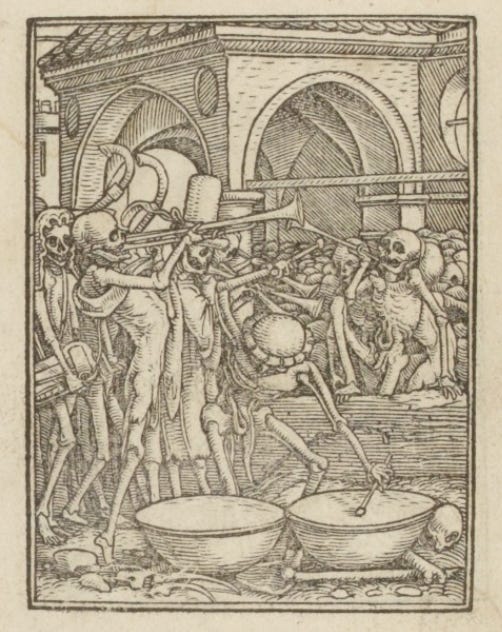
Memento Mori
Thinking about death is probably not the good vibes opener you were hoping for in the middle of a pandemic. But I’m not suggesting we obsess now over the grueling grief of our current moment—we are all, I imagine, doing that without prompting—or anything new, really.
Instead, I want to reflect together on one of the most important artistic allegories to come out of plagues and pestilence past: Memento Mori, reminders that everyone dies—not death itself.
Once you understand the inevitability of death, the knowledge of your own haunts you—and so it haunts humanity’s collective creative endeavors. In visual art, that can mean a lot of skulls. Sometimes as minor motifs tucked away in the back of a painting, sometimes as the building-blocks of chapels like the most morbid version of Minecraft imaginable.
But my personal favorite iteration is le danse macabre—a style popularized in the wake of the Black Death and noted for skeletons flailing in a ghoulish celebration that everyone ultimately ends. And the best illustrator of this style, for my money, is Hans Holbein the Younger.
Born in Germany (more specifically, Augsburg) in the late 1490’s—and unsurprisingly sired by Hans Holbein the Elder—Holbein is perhaps best known for his portraiture of the court of England’s Henry VIII. But even there, reminders of death are sometimes front and center—although they take a bit of perspective to see.
The most famous example is his painting The Ambassadors, which includes an elaborate (for the time and even now) visual illusion of a skull—obscured from the front of the painting, but viewable clearly from a certain angle.
But the Holbein I obsess over is his “Dance of Death” woodcut series: Dozens of images initially created in the 1520s (and eventually published together with religious text in 1538) featuring skeletal deaths interacting with peasant, pope, and everyone in between.
Hell, sometimes the skeletons are just throwing a party for their own bad selves, complete with brass and percussion sections—as featured at the top of this newsletter.
The woodcuts certainly shout “death comes for everyone!” But they’re a lot of, well, fun for something getting that message across.
And many of the woodcuts are detailed with that particular brand of biting religious and class satire that emerged from centuries of plague-related economic upheaval, and was brewing then as a reformation. (One, I will admit, I partially think too much about thanks to a Midwestern Lutheran upbringing.)
It’s not a coincidence that a devil lurks above the Pope’s head in Holbein’s vision, but the poverty-stricken old woman is gently led along to the end of her mortal path by one skeleton while being serenaded via portable marimba by another.
Thinking about death for Holbein and many of his contemporaries was not just “thinking about death,” it was thinking about life—and sometimes the hypocrisy of the powers that shaped it.
Yet even when surrounded by the harsh realities of mortality in their time, Holbein and other artists who deployed le danse macabre found ways to laugh about the absurdity of it all—often having death’s victims comically posed. Consider, the transgressive innuendo of The Nun’s distraction by a troubadour as a skeleton sneaks behind her to extinguish a candle:
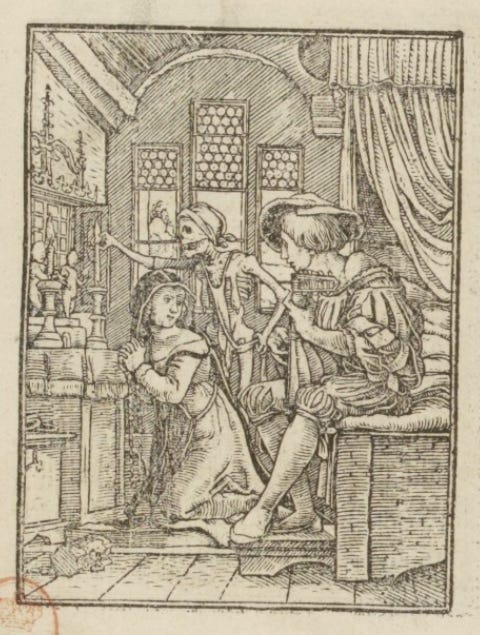
Or the mockery made of religious authority by a Chris Farley-esque Abbott’s emotive attempt to escape while being dragged towards the inevitable:
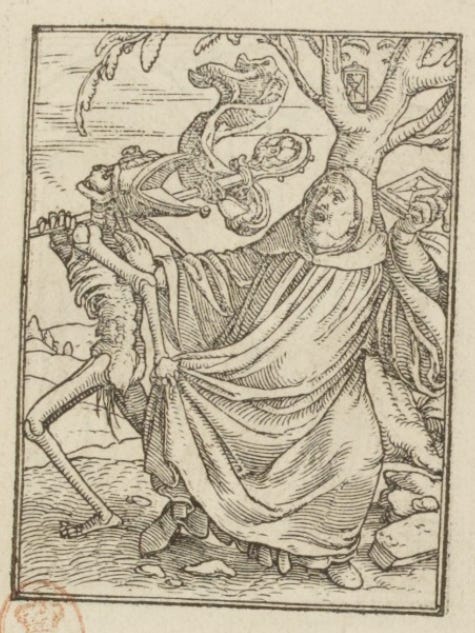
Of course, we’re still trying to joke our way into finding the darkest parts of life tolerable—and as Stassa Edwards wrote at Jezebel noted earlier this week, for some that means posting a literal danse macabre on TikTok.
But I also believe in the most earnest interpretation of Memento Mori, that it’s important to remember that we’re all going to die because it makes us appreciate each moment more.
That’s probably why my favorite detail in Holbein’s Dance of Death series is an hourglass motif he included most images, a nod to to the true currency of our lives: time. Sometimes it’s sitting on a table, displaced by a scene’s action, or even tucked away in a tree—as you can see in the Abbott woodcut above.
But for the old woman, the hourglass is shattered—but filled nearly to the brim with sand—in the bottom left corner. I like to imagine it represents time all too well spent.
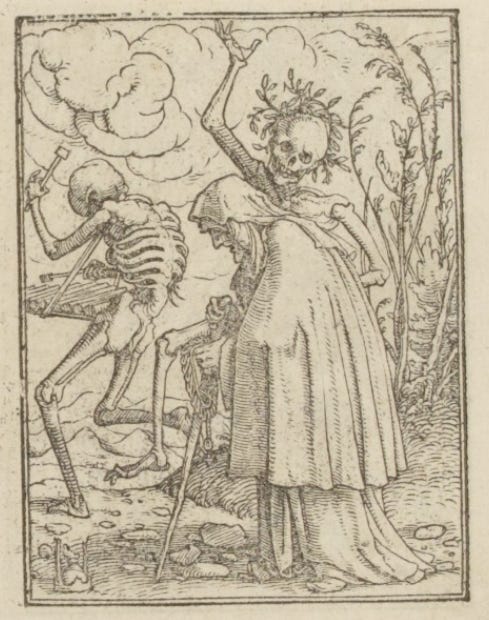
(One less than great final note: Holbein died in 1543, by most accounts, of plague.)
But wasn’t I promised a card game?
You were! And I have one for you: It’s called, well, Memento Mori and I made it based on the Holbein woodcuts. Many thanks to the friends who helped beta-test (over the years!?!) and especially Anne Higley, co-proprietor of the finest board game purveyor in Manhattan, KS—Goblin Games, who always encourages me to take my schemes too far.
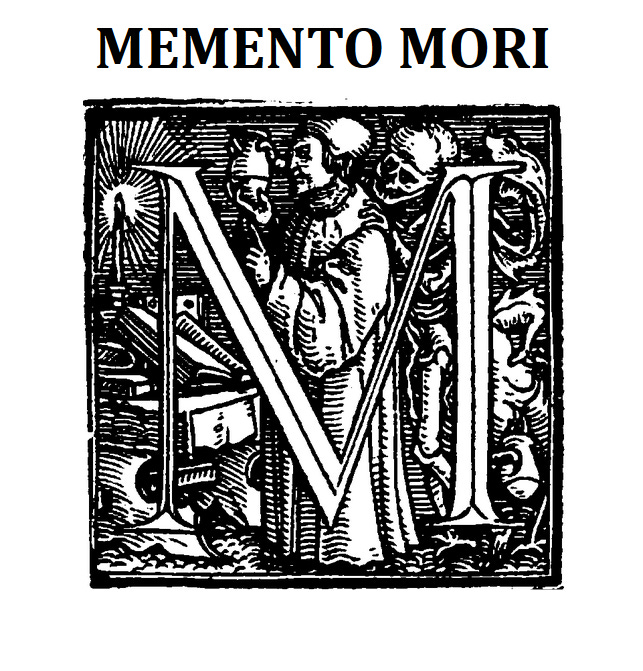
You can download a print-and-play beta here.
The game usually takes 45-90 minutes for 2-6 people to play and features three decks of custom tarot-sized cards —Mortals, Goals, and Death, each emblazoned on the back with a letter from Holbein’s skeletal alphabet. You’ll need 22-pages of paper, preferably on manila cardstock for an aged feel if you have it laying around, printed duplex for everything. I even made y’all a short watch and play video, but hopefully the instructions are mostly self-explanatory.
The gameplay is sort of a mix of Guillotine and Marrying Mr. Darcy, where you try to collect the most valuable hoard of souls from a medieval Castle’s Keep. All you’ll need are the three printable decks, the printable rules sheet/playmat, a d6 (or the ability to virtually roll one), and markers like pony-beads to move around the score tracker.
You can also play without keeping track and total points at the end to see who wins, in so much as anyone wins in a game where the goal is effectively killing everyone.
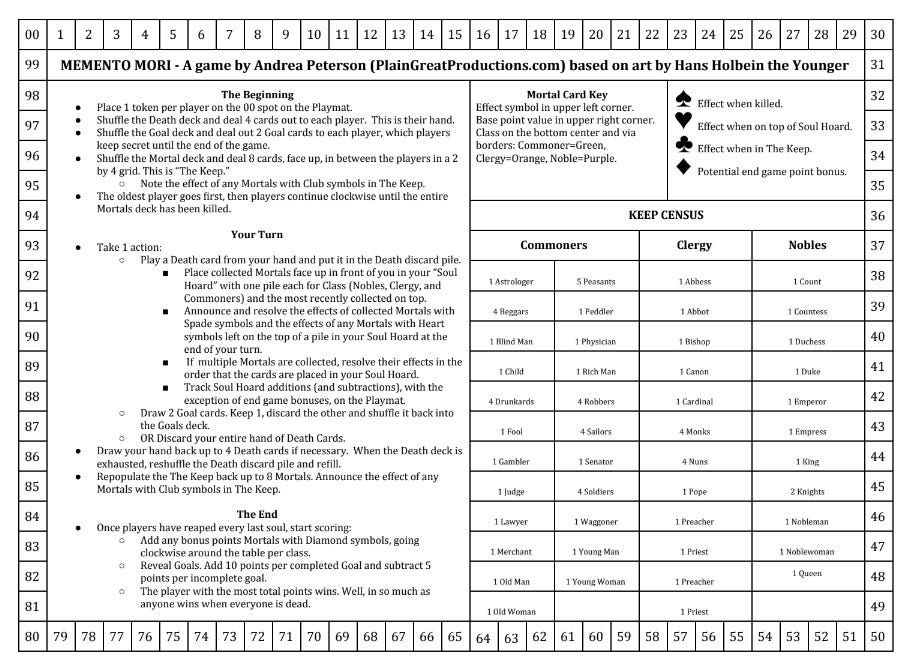
Honestly, win or lose, the real goal of the game is ultimately to help you kill time in a way that’s meaningful with people you care about. Now if only people actually had printers at home anymore.
Please forgive me for releasing a game with a plague mechanic into a pandemic. But if you embrace the inevitable and play it, please share a photo and your feedback with me via email here or on Twitter!
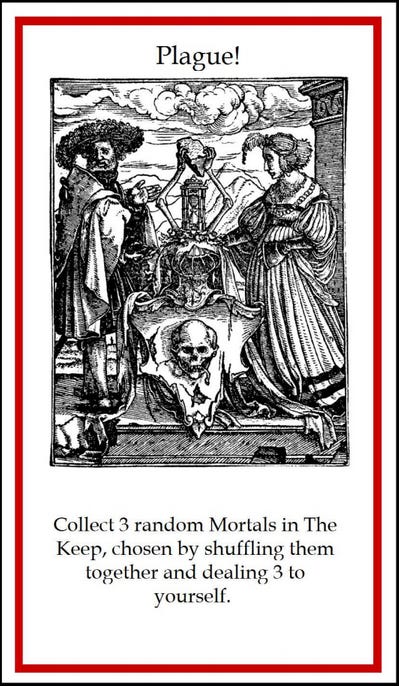
I may try to get Memento Mori professionally published eventually, but for now I’d love if you would help me play-test, share it with other folks who will appreciate it, and/or send cash my way if you’re somehow particularly flush at the moment—there’s an option on the game’s website to throw me $10 to “help fund my continued creation of strange things” if you really love it.
What else is great?
Well, on the subjects above…
Check out the 1538 edition of the collected woodcuts (technically titled Les simulachres et historiées faces de la mort, autant élégamment pourtraictes, que artificiellement imaginées) via Bibliothèque nationale de France—which was the source for images in this newsletter and the game.
Watch this lecture by Susan Foister of the National Gallery in London about Holbein’s The Ambassadors.
Read that whole Jezebel article on dancing our way through this bad year.
Get a closer look at the individual woodcuts and their publication history on this enthusiast web site, which also has a lot of info non-Holbein danse macabre imagery.
Otherwise, I’d firmly advise reading my dear friend Olga Khazan’s book Weird: The Power of Being an Outsider in an Insider World—which helped give me the last push I needed to go full weird on you all, even in the midst of our increasingly weird times.
If you need a soundtrack for your new always Zoom-streamed lifestyle, try Bacchae’s musical cursed monkey’s paw of a song Life Online, from their new(ish?) album Pleasure Vision. The launch show for the record at Songbyrd in early March was the last time I truly “went out.” I hugged friends—even those getting over a “cold!”—with such bravery! What a time it was to be alive! (Bacchae bandmember Andrew is also my fierce folk musical collaborator in MidMountain!)
Pets, Plants, and Partings
My pets and plants are always great and frequently make cameos on my @kansasalps Twitter. Here’s a vintage snap of Rolodex with his world turned upside down, just for the newsletter:
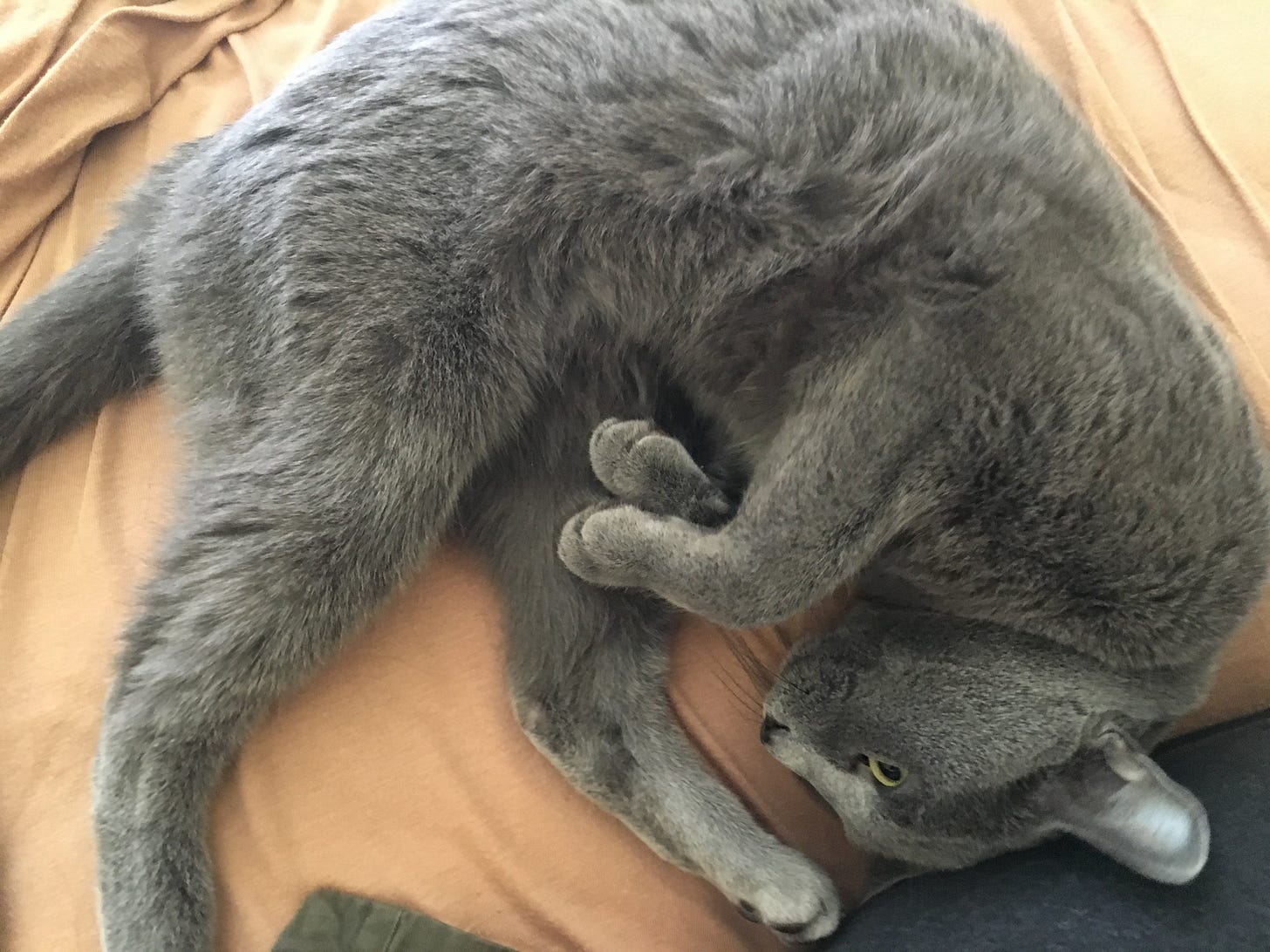
In the garden realm, my irises are up—huge stalks, weighted blooms, and the purest scent of spring. Here’s a recent glamour shot just before a DC sunset:

Look forward to more about the irises in future newsletters, especially as I’m eagerly awaiting when the yellow and white buds will burst open.
And a final, special thanks to fellow Sunflower State expat Patrice Hutton for being my very first subscriber—she is a hugely impressive person who runs Writers in Baltimore Schools.
Help me connect with more excellent people by sharing this with someone you think needs more good vibes right now (even if they’re sometimes about dark things) or sign yourself up for future updates below if you found this online or via a forward.
(I also promise, this newsletter won’t always be quite so spooky. Next week is about swimming!)
